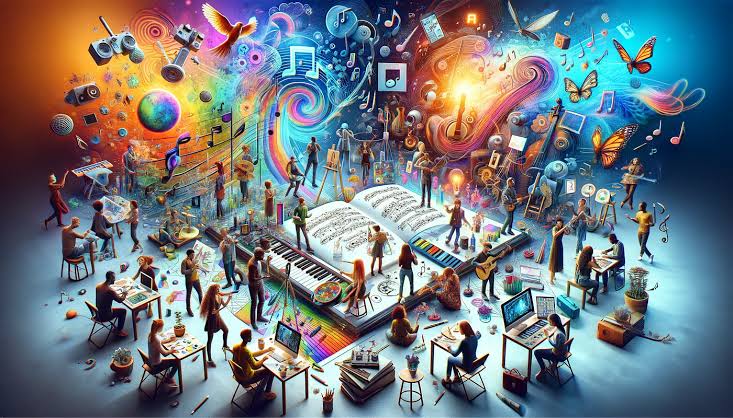Explore how AI art is democratizing creative expression by lowering barriers to entry, expanding creative possibilities, and fostering collaboration. Discover how AI tools are making art more accessible and reshaping the future of artistic practice.
AI in Art Making Creativity Available to Everyone
Artificial Intelligence (AI) is changing the landscape of our lives including the realm of art. AI powered tools are revolutionizing the process of creating art and opening up avenues, for expression to a wider audience. This newfound accessibility in creativity carries weight for both budding and seasoned artists alike as well as for the general populace.
Understanding AI Art
AI art refers to the creation of artworks using technology. This includes machine learning algorithms, neural networks and generative adversarial networks (GANs). AI art can be purely algorithmic or involve collaboration between humans and machines. The process typically involves training an AI model on a dataset of existing artworks to learn styles, techniques and themes. Once trained the AI can generate new artworks based on the patterns it has learned.
One aspect of AI art is its ability to produce outputs. AI algorithms can analyze amounts of data and create pieces that blend artistic styles or offer visual experiences. This potential for innovation opens doors for artists and broadens the scope of expression available to audiences.
How AI is Making Art More Accessible
AI art is playing a role, in making creative expression more inclusive through various means.
1. Making Art Accessible: In the past making art required skills, training and resources. However with the rise of tools the entry barriers have been lowered. Now even those with backgrounds in art can easily create visually appealing pieces. These tools come with interfaces and pre trained models allowing users to play around with styles and techniques without needing a deep understanding of art theory or practice.
2. Broadening Horizons: AI art tools offer users a range of creative possibilities that would be hard to achieve by hand. For instance algorithms can generate patterns, intricate compositions and unique visual effects that are challenging for artists to replicate. This expanded creative potential encourages individuals to explore new avenues and produce artwork that may not have been possible before.
3. Boosting Collaboration AI art tools promote collaboration, between artists and machines. Artists can utilize AI generated elements as starting points or sources of inspiration for their creations. This partnership can result in unique and fusion art forms that blend creativity with AI's capabilities. Moreover AI can aid in tasks like creating sketches or offering design ideas allowing artists to focus on refining and customizing their work.
4. Inspiring Artistic Exploration AI art tools encourage experimentation and discovery. Users can easily try out styles, colors and techniques without the fear of making mistakes. This hands on approach promotes a more playful and explorative mindset, in art creation helping individuals uncover their preferences and develop their artistic style.
5. Offering Artistic Tools And Resources: AI art platforms typically include features like templates, color schemes and style collections. These resources make it easier for people to access quality artistic tools and materials that they may not have had access to, without formal art education or financial means.
Implications for the Art World
The emergence of AI in the realm of artistry brings about consequences, for the industry impacting artists galleries and audiences in notable ways.
1. Evolving Roles in Artistry. With the rise of AI tools the role of an artist may undergo a transformation. Artists might take on the role of curators or facilitators guiding AI systems to achieve desired outcomes rather than solely crafting artwork from scratch. This shift could pave the way, for collaborations and reshape traditional concepts of authorship and creativity.
2. Redefining Boundaries. AI generated art challenges notions of art and ingenuity. The capability of AI to produce artwork sparks debates, on originality, authorship and the significance of intuition in the creative process. These challenges fuel ongoing conversations within the community about the essence of art and the worth of AI generated pieces.
3. Expanding Audience Engagement AI art has the ability to reach out to audiences by making the process of creating art more user friendly and engaging. Individuals who may not have seen themselves as artists before can now get involved in the creative journey and showcase their AI generated pieces to others. This increased participation can lead to a deeper appreciation, for art and encourage a wider range of artistic expressions.
4. Influencing Art Market Trends The emergence of AI art could have an impact, on the trends and valuations in the art market. As AI generated artworks gain recognition and popularity they may influence how art is collected displayed and valued. Art galleries and collectors may need to adjust to forms of art and consider the implications of AI's involvement, in the creative process.
Conclusion
AI art is revolutionizing the world of creativity by making art more accessible broadening opportunities for expression and promoting collaboration. With the help of AI tools barriers to entry are reduced artistic exploration is enriched and creators gain access to valuable resources. As AI art advances it will undoubtedly influence the future of artistic endeavors and capture the interest of audiences in ways. By embracing AI's potential the art industry can keep pushing boundaries and reshaping how we create and appreciate art.
